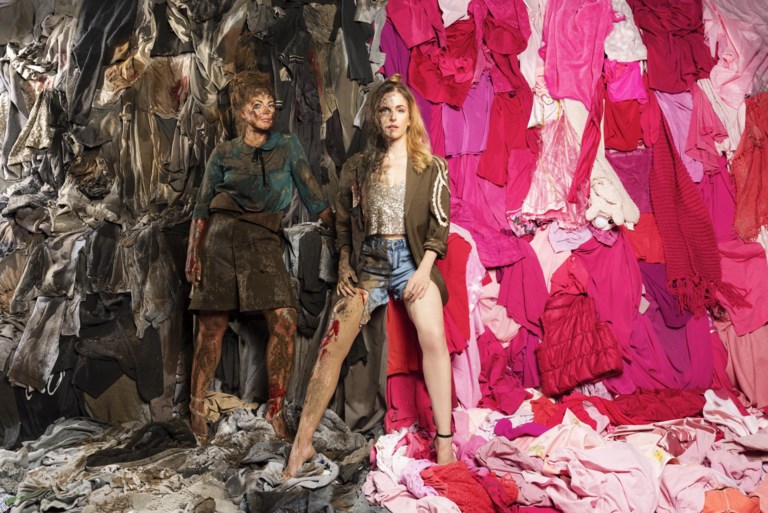With the rise of social media another new social phenomenon was born: fast fashion. This can be defined as trendy, often cheap clothing produced quickly and in high quantitives. Consumers buy these clothes for low prices and wear them usually for a short period of time. Fast fashion is often promoted by influencers through brand deals, partnerships and discount codes. Many influencers have up to millions of followers, thus becoming a beacon of fashion for many teenagers and young adults.
Environmental effects
So why would this be a bad thing? Well there are a few reasons. First of all, fast fashion is bad for the environment. Pollution already takes place during the production of the raw materials and materials from which the clothing is made and continues when the clothing is transported around the world, and even when it is thrown away by the consumer. The clothing industry accounts for 10% of global CO2 emissions and 20% of global wastewater, and 35% of all mircroplastics in our oceans come from the synthetic materials of fast fashion articles. And sure, also ‘slow’ fast is to some extent bad for the environment, however because fast fashion articles are usually made extremely quick and worn for a short period of time by the consumers, a lot more fast fashion is being made and thrown away than other fashion. This makes the overall production of fast fashion very wastefull.
Horrible working conditions
Secondly, fast fashion is usually produced under terrible working conditions. Most commonly know are the conditions of factory employees in Bangladesh. These people work with no ventilation, beathing in toxic substances and fiber dust. Moreover, accidents, fires, injuries and diseas are not uncommon in these workplaces. Employees usually work up to twelve hours a day for ridiculously low wages. And if that is not bad enough, many of these employees are children, and face verbal and physical abuse.
Planned obsolensce
Also, fast fashion has a low quality. For the producers of fast fashion this is a good thing, because the customers have to buy clothing more often, seeing that their products are short-lived. This is called planned obsoscence: products are consciously designed with a limited lifespan so that you need to quickly buy them again. Because the clothing is so cheap, buying a new version of the article is almost cheaper than getting it fixed. This creates of vicious cycle constantly buying this type of clothing. Combined with the bad working conditions, this obviously makes these companies a great deal of money and is highly exploitative.
The influencers
Regardless of these cons of fast fashion, countless of influencers still promote these brands. A few examples are: TopShop, Primark, Fashion Nova, Boohoo, Pretty Little Thing, Missguided and Shein. I think you will recognise at least one of these brands if you like watching and (try on) hauls. These brands pay influencers a lot of money to promote their clothing. Influencers sometimes have up to millions of followers, many retailers now know to use this to their advantage and promote theselves endlessly. Often influencers get provided with a discount code to share with their followers. Their influence is tracked by the amounts of times a discount code is used, for this a influencer earn commission. They indirectly promote damage to the environment and bad working conditions/child labour because they get paid to not say anything negative about these labels and thus not giving the truth to their young/impressionable audience about the quality and effects of buying these clothes.
How we can help
Paying less for cute articles of clothing feels good in the moment, but is bad in a lot of ways in the long run. My advice for you is to thoroughly research a clothing brand before you buy something from them. It is very much worth investing in a few timeless, but maybe more expensive fashion items. The amount of wear you get from these items far exceeds the cost, and even makes them cheaper per wear than easily ruined and cheaply made items from fast fashion labels. I myself am a hundred percent guilty of buying from fast fashion brands, but I pretty much stopped because I realised I was throwing my money away by buying cheaply made, ill fitting clothing that I had to replace after washing/wearing it maybe 5 times. By buying less from fast fashion brands and not blindly following influencers and celebrities you and me can contribute a bit to slowing down climate change and improving working conditions for empoyees of fast fashion brands.

Sources
Le, N. (2020). The impact of fast fashion on the environment. https://psci.princeton.edu/tips/2020/7/20/the-impact-of-fast-fashion-on-the-environment
Maud. (2021, 26 january). 4 redenen om nu écht niet meer voor fast fashion te kiezen. https://www.takeitslowstore.com/nl/blogs/slow-blog/kies-niet-voor-fast-fashion/
Rebecca. (2019). A Complete list of 25 fashion brands to avoid and why. https://www.minimalismmadesimple.com/home/fast-fashion-brands/
Siegle, L. (2019, 2 july). How Instagram Influencers Fuel Our Destructive Addiction To Fast Fashion. https://www.huffpost.com/entry/fast-fashion-influencers-instagram-fashion-nova-waste-climate-change_n_5c5ae8ffe4b0871047598750
Sudha, M., & Sheena, K. (2017). Impact of influencers in consumer decision process: the fashion industry. SCMS Journal of Indian Management, 14(3), 14-30.Sudha, M., & Sheena, K. (2017).


I’m a big supporter of “slow” fashion which I was drawn to your article. Recently Molly Mae, a very popular British influencer, became the creative director of Pretty Little Thing. Instead of using her platform to call for greater change, she has committed to continuing pre-existing and detrimental practices. Unfortunately, this shows that some influencers are going beyond just promoting fast fashion, and now have an even greater stake in ensuring it survives.